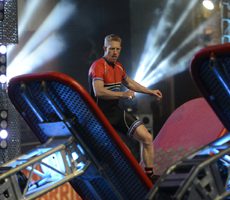- June 29, 2015
- By Karen Shih ’09
David Bozak ’97 can’t tell you how well he’ll do on tonight’s episode of “American Ninja Warrior” (ANW), NBC’s hit summer show.
But take one look at plane-jumping, high-diving, fire-defying escapades from his submission video, and it’s clear this is the stage the Pennsylvania doctor’s been waiting for—he even built a climbing wall in his basement to prepare for the extreme obstacle-course competition.
“I’ve been watching the show for years, and I definitely thought, ‘I could do that,’” says Bozak. “I wanted to prove something to myself—put myself to the test.”
ANW was born six years ago from “Sasuke,” a Japanese show created in 1997. Japanese contestants face four rounds of obstacles (with muddier pits to fall into), are subject to more irreverent commentary and the whole show airs in one three-hour segment. But in the sleek and more serious U.S. version, the show goes on all summer long, and contestants must conquer six rounds of obstacles, two at the city competition and four at the Las Vegas finals, to win the $1 million grand prize.
They need a mix of strength (particularly in their upper body), balance and creativity to tackle established obstacles such as the salmon ladder (which requires jumping pull-ups to climb the rungs), the 14-foot warped wall (worse than a sheer cliff face—it curves out) and the quintuple steps (angled boards that require zig-zagging leaps), as well as challenging new ones the diabolical producers come up with each year.
What’s unique about ANW is that contrary to virtually every American competition show, there doesn’t have to be a winner. In 31 seasons of “Sasuke,” just three men have defeated the final obstacle, “Mount Midoriyama,” which requires contestants to climb a 75-foot rope—and no American has even gotten that far.
The drive to become the first is what spurred Bozak and thousands of others to send in applications. When he was selected to compete in Pittsburgh, one of five cities where the competition was held this year, he ramped up his already-vigorous training to focus on the course. Luckily for him, “ninja” and “parkour” gyms have sprung up across the country, including in nearby Baltimore, thanks to the more than 6 million viewers who tune in each week. That gave Bozak places to practice in the weeks leading up to the real deal in May.
But even with all the preparation, “the obstacles are more intimidating in person than on TV,” Bozak says. “It’s a huge production.”
The show is shot exclusively after dark, so some unlucky contestants have to wait until the wee hours of the morning for their turn. Bozak, however, got to compete in the early evening so his wife and two young daughters, ages 1 and 2, could cheer him on.
“Between the obstacles, I’d look down and blow them a kiss,” he says.
He didn’t get support from just his family, either. “The great thing about the show is the camaraderie,” he says. “Nobody wants anybody else to fail.”
That’s also what drew Bozak to Gymkana as a student at UMD. He grew up doing diving and gymnastics, but he decided against competing at the collegiate level. When he got to Maryland, he was excited for the chance to train and perform in a more laid-back atmosphere. He liked its drug- and alcohol-free message and spent most of his free time with the troupe.
“I love being upside down,” he says. “I love flipping, being in the air and the incredible technical skill it requires, to figure out how to move your body through space.”
These days, however, when he’s not working as a physiatrist to rehabilitate patients with movement issues or training for ANW, he’s focused on staying right-side up as a Category 1 competitive bike racer (the highest amateur level). He competes about 30 times a year and won the 2012 national championship in the “team pursuit” category.
Many top contestants now train full-time for ANW, but going up against professional rock-climbers, stunt men and gym owners didn’t intimidate Bozak.
“People that run the course aren’t just one type of athlete,” he says. “They come from different walks of life. What makes the show so interesting is the combination of the intrigue of the obstacle course, just how difficult it is, and a lot of really good stories about people.”
“AMERICAN NINJA WARRIOR” airs Mondays at 8 p.m. on NBC.
